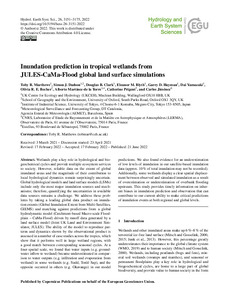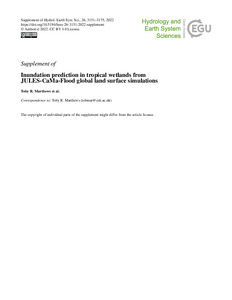Por favor, use este identificador para citar o enlazar este ítem:
http://hdl.handle.net/20.500.11765/13837
Inundation prediction in tropical wetlands from JULES-CaMa-Flood global land surface simulations
| Título : | Inundation prediction in tropical wetlands from JULES-CaMa-Flood global land surface simulations |
| Autor : | Marthews, Toby R.; Dadson, Simon J.; Clark, Douglas B.; Blyth, Eleanor M.; Hayman, Garry D.; Yamazaki, Dai; Becher, Olivia R. E.; Martínez de la Torre, Alberto |
| Palabras clave : | Inundation prediction; Tropical wetlands; Land surface simulations; Global hydrodynamic model |
| Fecha de publicación : | 2022 |
| Editor: | Copernicus Publications; European Geosciences Union |
| Citación : | Hydrology and Earth System Sciences. 2022, 26(12), p. 3151–3175 |
| Versión del editor: | https://doi.org/10.5194/hess-26-3151-2022 |
| Resumen : | Wetlands play a key role in hydrological and biogeochemical cycles and provide multiple ecosystem services to society. However, reliable data on the extent of global inundated areas and the magnitude of their contribution to local hydrological dynamics remain surprisingly uncertain. Global hydrological models and land surface models (LSMs) include only the most major inundation sources and mechanisms; therefore, quantifying the uncertainties in available data sources remains a challenge. We address these problems by taking a leading global data product on inundation extents (Global Inundation Extent from Multi-Satellites, GIEMS) and matching against predictions from a global hydrodynamic model (Catchment-based Macro-scale Floodplain – CaMa-Flood) driven by runoff data generated by a land surface model (Joint UK Land and Environment Simulator, JULES). The ability of the model to reproduce patterns and dynamics shown by the observational product is assessed in a number of case studies across the tropics, which show that it performs well in large wetland regions, with a good match between corresponding seasonal cycles. At a finer spatial scale, we found that water inputs (e.g. groundwater inflow to wetland) became underestimated in comparison to water outputs (e.g. infiltration and evaporation from wetland) in some wetlands (e.g. Sudd, Tonlé Sap), and the opposite occurred in others (e.g. Okavango) in our model predictions. We also found evidence for an underestimation of low levels of inundation in our satellite-based inundation data (approx. 10 % of total inundation may not be recorded). Additionally, some wetlands display a clear spatial displacement between observed and simulated inundation as a result of overestimation or underestimation of overbank flooding upstream. This study provides timely information on inherent biases in inundation prediction and observation that can contribute to our current ability to make critical predictions of inundation events at both regional and global levels. |
| Patrocinador: | This research has been supported by the Natural Environment Research Council (grant no. NE/S017380/1). |
| URI : | http://hdl.handle.net/20.500.11765/13837 |
| ISSN : | 1027-5606 1607-7938 |
| Colecciones: | Artículos científicos 2019-2022 |
Ficheros en este ítem:
| Fichero | Descripción | Tamaño | Formato | ||
|---|---|---|---|---|---|
| HESS_Marthews_2022.pdf | 8,4 MB | Adobe PDF |  Visualizar/Abrir | ||
| Supplement.pdf | 141,93 kB | Adobe PDF |  Visualizar/Abrir |
Los ítems de Arcimis están protegidos por una Licencia Creative Commons, salvo que se indique lo contrario.





